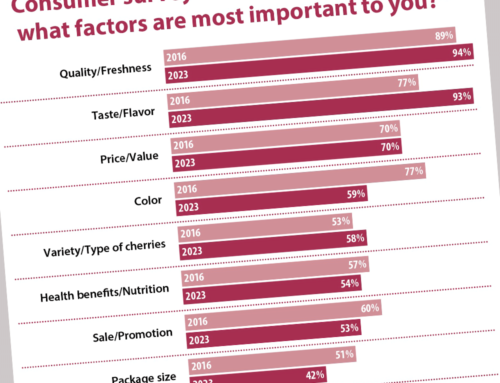It’s a topic no one wants to discuss.
But family fruit growers should ask themselves one critical question: What would happen if you die tomorrow?
If there isn’t already a succession plan in place — and ideally with transition activities well underway — there’s a good chance the family business will not continue beyond the current generation.
Indeed, only about 30 percent of all family-owned businesses transition to the second generation, according to business service firm PricewaterhouseCoopers.
For independent growers, in particular, the need for succession planning has never been more critical. According to Cascadia Capital, the number of independent growers dropped from 4,000 to 1,450 between 2010 and 2020 due to consolidations and an influx of venture capital.
Consolidation has put additional pressure on family operations to match the efficiencies of competitors funded with billions of equity investor dollars. This results in ever-tighter profit margins for smaller family businesses: Around 70 percent of small farms operate with less than 10 percent profit margins; about 17 percent operate with more than 25 percent profit margins, according to Cascadia Capital.


Take control for a strategic advantage
Unlike labor laws, occupational safety laws and tax laws, succession planning is one of the few things family-owned fruit growers can use now to take control of their family business’ destiny, rather than having it dictated to them in the future.
The reason some family businesses last longer than others can often be traced to the work they put into succession planning. That’s because such planning involves:
—A forward-looking perspective. Involving younger generations gives family businesses a long investment horizon that can better weather challenging economic times.
—A focus on quality. Because their name is on the door and they don’t want to negatively affect their reputation in the community, it encourages family fruit growers to invest in quality.
—A deep investment. Family members working in the business are deeply invested in the outcome, living and breathing the business. This sweat equity can positively impact nonfamily employees, too.
—Accumulated experience. The more involved both family and nonfamily members are in the business, the more it benefits from generations of knowledge and experience.
Navigating the emotion
Planning for succession of a family ag business is, naturally, an emotional and sometimes difficult process.
All family businesses have challenges related to family dynamics. That’s why it’s a good idea to involve other professionals who don’t have a personal interest in the business succession. Financial planners, estate attorneys, accountants and others can help keep succession conversations on track if emotions begin to interfere. That includes helping to ensure critical tasks are carried out in a timely manner and updates are completed as necessary.
It’s important to have the support and guidance of professionals who have specialized knowledge of and expertise in the unique rules, regulations and exemptions that apply to farm and ag businesses, such as valuation discounts and certain exclusions, along with insurance products, annuities and the particulars of estate, income and capital gains taxes.
Fortunately, once the initial succession plan is in place, reviewing and updating it annually becomes far less emotional and simply a strategic best practice.
The basics
Fear of the unknown is often what blocks progress, so, with that in mind, here are the types of considerations that go into a succession plan:
—Business net worth. The inflows, outflows, liquid assets, illiquid assets, taxes, loan debts, etc. that comprise the composition and net value of the business. It’s important, as well, to document ownership of assets, debts and accounts.
—The “secret sauce.” The unique goals, mission and values that have made the family business a success and will serve to guide future generations.
—Work and skills matrix. This means not only the work duties of family members and others who are working the day-to-day operations of the business, but also their skill sets. That goes for both the generation expecting to retire and the generation(s) expecting to continue running the business, so that, if necessary, training and mentoring can begin prior to a transition to backfill the skills and experience of those who are retiring. It’s not uncommon in the fruit-growing industry to hear of owners starting these conversations, skills sharing and knowledge transfer with their preteen children.
—Balanced board. Include independent, professional directors, because they can bring a broader market perspective to help stave off the competition.
—Contingency planning. Most succession plans are based on a targeted retirement date, but what happens if an owner becomes too sick to participate in the business, or even dies? Having a contingency plan in place can help get everyone quickly onto the same page, delineate roles and reduce stress if the unexpected happens.
—Transition planning. Once there’s an agreed-upon date for the actual succession from one generation to the next, it’s time to start transitioning. Working backward from the target succession date, transition activities can include gifting assets to family members, forming limited partnerships or limited liability companies with family members, adding successors as primaries on loans and banking accounts, and cross-training and mentoring successors so that they know how to manage the business.
—Dividend policy. This needs to take into account those both inside and outside the business.
—Transparency. Every stakeholder should understand the succession plan and be included in updates. Again, this can be especially helpful in the event of illness or death.
The last thing a family wants is for the family business to be forced into liquidation by unexpected medical expenses or death — or a simple lack of planning for the inevitability of retirement. Doing the work of creating a succession plan now can help family-owned growers ensure their legacy.
—by Rob Blethen and Brad Hansen
Rob Blethen is a certified financial planner and executive vice president with D.S. Baker Advisors. Brad Hansen, MBA, is a certified trust and fiduciary advisor, vice president and senior trust and family advisor with Baker Boyer. Baker Boyer is a nationally chartered bank, founded in 1869 in what would later become the state of Washington. For more information, go to: bakerboyer.com.




Leave A Comment